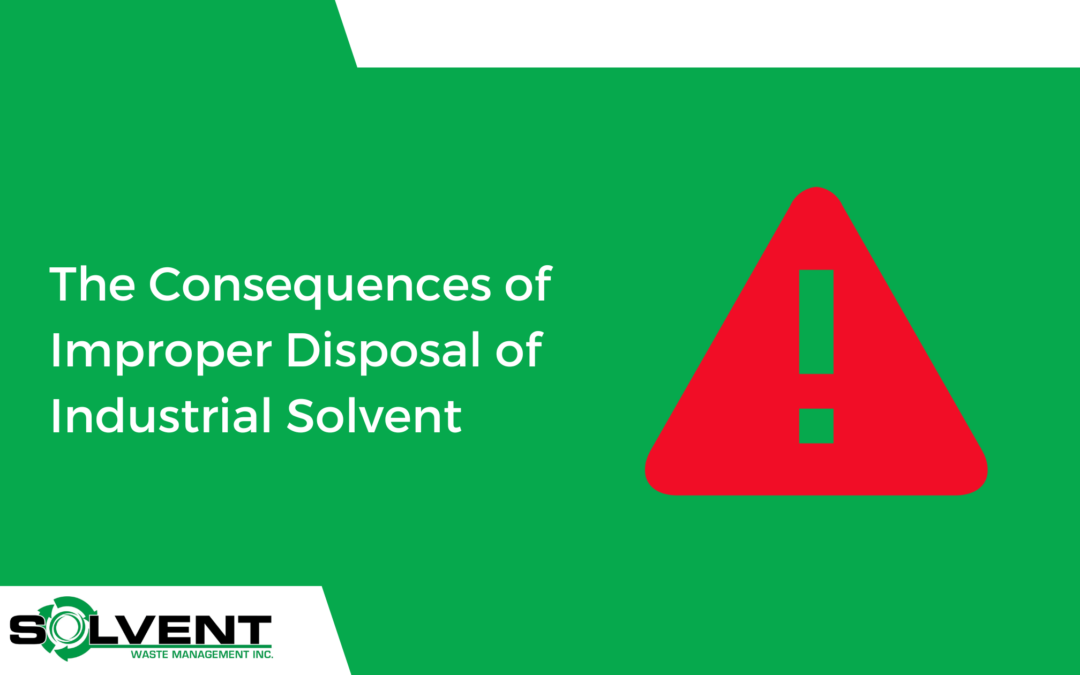Industrial solvents play a critical role in various manufacturing processes across industries. These versatile chemicals are used for cleaning, degreasing, and as a vital component in the production of numerous products.
However, improper disposal of industrial solvents can have severe consequences for the environment, human health, and ecosystems.
In this comprehensive blog, we will delve into the risks associated with improper disposal of industrial solvents.
We will explore the potential environmental impacts, health hazards, regulatory implications, and best practices for safe and responsible solvent disposal.
Understanding these risks is crucial for industries and businesses to adopt sustainable waste management practices and mitigate the adverse effects on our planet.
1. Understanding Industrial Solvents
Industrial solvents are organic chemicals with properties that dissolve, disperse, or extract other substances. Common industrial solvents include acetone, toluene, xylene, methylene chloride, and ethyl acetate, among others.
These solvents are widely used in manufacturing, cleaning, and various industrial processes due to their ability to dissolve oils, greases, resins, and other compounds.
2. The Environmental Risks
Improper disposal of industrial solvents poses significant environmental risks. When solvents are released into the environment, they can contaminate soil, water bodies, and the air.
Solvents may persist for extended periods, leading to long-term pollution. Some of the major environmental risks include:
- Water Contamination: Solvents can leach into groundwater, rivers, and lakes, contaminating drinking water sources and aquatic ecosystems. Prolonged exposure to contaminated water can be harmful to marine life and lead to bioaccumulation in the food chain.
- Soil Contamination: Improper disposal of solvents on land can result in soil pollution. Contaminated soil can hinder plant growth, affect agricultural productivity, and further contribute to water pollution if the solvents leach into groundwater.
- Air Pollution: Volatile solvents can evaporate into the atmosphere, contributing to air pollution. When these volatile organic compounds (VOCs) react with sunlight, they form ground-level ozone, a harmful air pollutant known to cause respiratory issues.
3. Health Hazards for Humans
In addition to environmental risks, improper disposal of industrial solvents can have severe health implications for humans. Exposure to solvents through inhalation, skin contact, or ingestion can lead to various health issues, such as:
- Respiratory Problems: Inhalation of solvent vapors can cause respiratory irritation, leading to coughing, shortness of breath, and exacerbation of pre-existing respiratory conditions.
- Neurological Effects: Some solvents are neurotoxic and can adversely affect the central nervous system. Long-term exposure may result in neurological disorders, including memory loss, headaches, and dizziness.
- Skin Irritation: Direct skin contact with solvents may cause skin irritation, redness, and dermatitis. Prolonged exposure can lead to more severe skin conditions.
- Carcinogenicity: Certain solvents have been classified as carcinogens, posing an increased risk of cancer development after prolonged exposure.
4. Legal and Regulatory Implications
Improper disposal of industrial solvents is not only harmful to the environment and human health but also carries legal and regulatory consequences.
Governments and environmental agencies have stringent regulations in place to monitor the proper handling, storage, and disposal of hazardous waste, including industrial solvents.
Failure to comply with these regulations can result in fines, penalties, and legal liabilities for businesses and industries.
5. Best Practices for Safe Solvent Disposal
To mitigate the risks associated with improper disposal of industrial solvents, adopting responsible waste management practices is essential. Here are some best practices for safe solvent disposal:
- Recycling and Reuse: Whenever possible, consider recycling and reusing solvents. Implement solvent recovery systems to reclaim and reuse solvents, reducing waste generation.
- Use Safer Alternatives: Explore non-toxic or less hazardous solvents as alternatives in industrial processes. Choosing greener options can minimize environmental and health risks.
- Proper Storage: Store solvents in designated containers and areas that prevent leakage or spillage. Label containers clearly and securely to avoid cross-contamination.
- Seek Professional Disposal Services: Engage with licensed and reputable hazardous waste disposal companies for safe collection and disposal of solvents.
- Employee Training: Provide comprehensive training to employees about proper solvent handling, storage, and disposal procedures to ensure compliance with regulations.
- Regular Inspections and Maintenance: Conduct regular inspections of storage areas and equipment to identify potential issues early on and address them promptly.
Conclusion
The risks associated with improper disposal of industrial solvents are far-reaching and can have devastating consequences for the environment, human health, and businesses.
As responsible stewards of the planet, it is incumbent upon industries to adopt sustainable waste management practices and prioritize the safe disposal of solvents.
By incorporating solvent recycling, reusing, and greener alternatives, businesses can minimize their environmental footprint and protect both the planet and the well-being of their workforce. Let us all take a collective step towards safer and more sustainable solvent disposal, safeguarding our world for generations to come.

